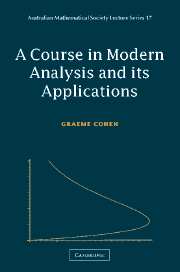2 - Metric Spaces
Published online by Cambridge University Press: 06 July 2010
Summary
Definition of a metric space
In Chapter 1 we went into some detail regarding properties of convergent sequences of real or complex numbers. The essential idea of convergence is that distances between points of the sequence and some other point become smaller and smaller as we proceed along the sequence. We need not restrict this notion to sequences of numbers and indeed, in discussing uniform convergence of sequences of real-valued functions with a common domain, we have already extended it. All that is required to speak of convergence of a sequence of elements of any particular set is that a meaning be given to the concept of the distance between points of that set. If we can come up with an adequate definition of ‘distance between points’ that is applicable in a totally general setting, then any consequences of that definition will be reflected in particular examples.
Thus we arrive at our first instance of an abstract space (apart from our introduction to vector spaces). A metric space is an arbitrary set X together with a real-valued mapping d defined on pairs of elements x and y in X such that the number d(x, y) suitably represents the idea of the distance between the points x and y. Defining d so that it does this job is not easy: we wish to ensure that the single definition can, in its various applications, fully account for what we already understand by distances between numbers on a line or between points in the plane, and that it can distinguish functions whose graphs are close together or far apart.
- Type
- Chapter
- Information
- A Course in Modern Analysis and its Applications , pp. 84 - 112Publisher: Cambridge University PressPrint publication year: 2003

